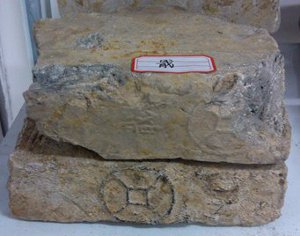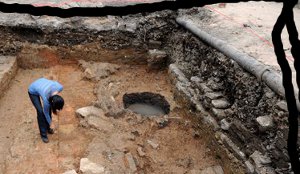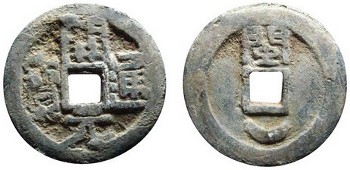The ruins of an ancient city wall dating from the Tang Dynasty were recently discovered in Fuzhou (福州), the capital city of China’s southeastern province of Fujian (福建), according to a local newspaper article.
The city wall dates back 1,100 years and is unusual because some of the bricks display the design of an ancient Chinese cash coin. Cash coins were distinctive because of their round shape with a square hole in the center.

Coin design on wall bricks of Kingdom of Min
The coin design can be clearly seen on the bottom brick in the picture at the left. The coin design is also on the upper brick just to the right of center.
The discovery of the bricks with the coin design allowed archeologists to identify the site as the ruins of a city wall from the time of the Kingdom of Min (909-945 AD).
Construction of the wall began in the year 901 under the direction of Wang Shenzhi (王审知) who was the military commissioner for the area under the Tang Dynasty.
However, the great Tang Dynasty collapsed in 907, and in the year 909 Wang Shenzhi named himself the Prince of Min (閩忠懿王; Emperor Taizu of Min 闽太祖) and the ruler of the Kingdom of Min.
Historical records specifically mention the unusual coin design on the bricks used to build the “Luo city wall” (罗城).
Confirmation that the archaeological find is indeed the famous “Luo wall” of the Kingdom of Min was obtained when other bricks were discovered to have the Chinese characters 威武军 (wei wu jun) which translates as the “Powerful Army”. Wei Wu Jun was the name of the army Wang Shenzhi commanded.

Ancient city wall from Kingdom of Min
The newly unearthed ancient wall can be seen in the image at the left. The wall thus far unearthed measures 74 meters in length and 8 meters in width.
Historical records describe the wall as having been severely damaged in battles during the Song Dynasty (960-1279).
In more recent times, the site was used as a garbage dump and later became the location of a transport station.
Wang Shenzhi is well known to collectors of ancient Chinese coins because he predominately issued coins made of lead or iron. While lead and iron coins had been cast in earlier dynasties, most coins were made of bronze.
However, the coin design on the wall bricks actually has nothing to do coins!
The Chinese character for “cash coin” (qian 钱) also happens to be a Chinese surname or family name.
The surname of the ruling family of the neighboring kingdom of Wuyue was Qian (钱) which is the very same Chinese character used for “coin”.
In 916, Wang Shenzhi arranged for the marriage of his daughter to Qian Chuanxiang (钱传珦) who was the son of Qian Liu (钱鏐) the King of Wuyue (吴越国).
It was a common practice for rulers to try to marry their offspring to important family members of neighboring states in order to establish strong diplomatic ties.
The image of the coin on the city wall bricks was intended to symbolize the marriage and the newly established ties to the Qian family of the Kingdom of Wuyue.
The Kingdom of Min would only exist for a short time after Wang Shenzhi’s death in 925.
Li Hongxi (李弘羲) became ruler of Fuzhou in 945 but was forced to surrender to the forces of Wuyue.
The King of Wuyue at the time was Qian Hongzuo (钱弘佐; Qian Zuo 钱佐) who was the nephew of Qian Chuanxiang.
The Qian family of Wuyue thus became the new rulers of Fuzhou. It is said that the citizens of Fuzhou considered the coin design on the bricks of the Luo Wall to have been an omen predicting that the Qian family would one day rule the country.
As mentioned earlier, Wang Shenzhi is known for having been among the first to use lead for the regular production of cash coins.

Large lead coin from Kingdom of Min
An example of a large lead coin cast during Wang Shenzhi’s reign is displayed at the left.
The inscription on the obverse side is kai yuan tong bao (開元通寶) which is the same as that on the coins of the Tang Dynasty.
The reverse side has the Chinese character min (閩) indicating the Kingdom of Min.
These large coins made of lead or iron from the Kingdom of Min are fairly scarce. Specimens made of bronze are even rarer.